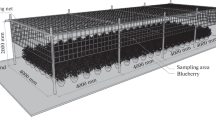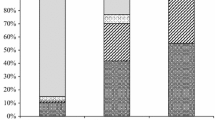Abstract
We monitored accumulation in terms of different types of anthocyanidin, in association with fruit skin coloration, in ‘Bluecrop’ highbush blueberry (Vaccinium corymbosum L.) at three stages of ripening: pale green, ca. 30 days after full bloom (DAFB); reddish purple, ca. 40 DAFB; and dark purple, ca. 50 DAFB. Total anthocyanin contents increased during ripening, while fruit skin color steadily became darker and bluer, as reflected in decreasing L* (a color space coordinate describing lightness) and b* (describing blue-yellow coloration). Of the six anthocyanidins commonly found in fruits, pelargonidin was absent throughout the ripening process. Cyanidin was first detected at the pale green stage. Peonidin, delphinidin, petunidin, and malvidin were first detected after fruits had passed through the reddish purple stage. The contents of delphinidin and malvidin increased more rapidly than those of other anthocyanidins, and were closely correlated with changes in fruit skin color, demonstrating that the types and quantities of anthocyanidins, which in turn form anthocyanins, were major determinants of fruit skin coloration. Four anthocyanins were detected at the reddish purple stage, and 22 were identified at the dark purple stage. All anthocyanins detected were glycosylated with glucose, galactose, or arabinose.
Similar content being viewed by others
Literature Cited
Azuma A, Ban Y, Sato A, Kono A, Shiraishi M, Yakushiji H, Kobayashi S (2015) MYB diplotypes at the color locus affect the ratios of tri/di-hydroxylated and methylated/non-methylated anthocyanins in grape berry skin. Tree Genet Genomes 11:1–13
Bailly C, Cormier F, Do CB (1997) Characterization and activities of S-adenosyl-L-methionine:cyanidin 3-glucoside 3’-O-methyltransferase in relation to anthocyanin accumulation in Vitis vinifera cell suspension cultures. Plant Sci 122:81–89
Butelli E, Titta L, Giorgio M, Mock HP, Matros A, Peterek S, Schijlen EGWM, Hall RD, Bovy AG, Luo J, et al (2008) Enrichment of tomato fruit with health-promoting anthocyanins by expression of select transcription factors. Nat Biotechnol 26:1301–1308
Castellarin SD, Gambetta GA, Wada H, Shackel KA, Matthews MA (2011) Fruit ripening in Vitis vinifera: spatiotemporal relationships among turgor, sugar accumulation, and anthocyanin biosynthesis. J Exp Bot 62:4345–4354
Dussi MC, Sugar D, Wrolstad RE (1995) Characterizing and quantifying anthocyanins in red pears and the effect of light quality on fruit color. J Am Soc Hortic Sci 120:785–789
Ehlenfeldt MK, Prior RL (2001) Oxygen radical absorbance capacity (ORAC) and phenolic and anthocyanin concentrations in fruit and leaf tissues of highbush blueberry. J Agric Food Chem 49:2222–2227
Gao L, Mazza G (1995) Characterization of acetylated anthocyanins in lowbush blueberries. J Liq Chromatogr 18:245–259
Gavrilova V, Kajdzanoska M, Gjamovski V, Stefova M (2011) Separation, characterization, and quantification of phenolic compounds in blueberries and red and black currants by HPLC-DAD-ESI-MS n. J Agric Food Chem 59:4009–4018
Giusti MM, Wrolstad RE (2001) Characterization and measurement of anthocyanins by UV-visible spectroscopy. In RE Wrolstad, TE Acree, EA Decker, MH Penner, DS Reid, SJ Schwartz, CF Shoemaker, DM Smith, P Sporns, eds, Current Protocols in Food Analytical Chemistry. John Wiley & Sons, NY, USA, pp 1.2.1-1.2.13
Giusti MM, Wrolstad RE (2003) Acylated anthocyanins from edible sources and their applications in food systems. Biochem Eng J 14:217–225
Guyer L, Hofstetter SS, Christ B, Lira BS, Rossi M, Hortensteiner S (2014) Different mechanisms are responsible for chlorophyll dephytylation during fruit ripening and leaf senescence in tomato. Plant Physiol 166:44–56
Howard LR, Clark JR, Brownmiller C (2003) Antioxidant capacity and phenolic content in blueberries as affected by genotype and growing season. J Sci Food Agric 83:1238–1247
Hugueney P, Provenzano S, Verries C, Ferrandino A, Meudec E, Batelli G, Merdinoglu D, Cheynier V, Schubert A, Ageorges A (2009) A novel cation-dependent O-methyltransferase involved in anthocyanin methylation in grapevine. Plant Physiol 150:2057–2070
Jaakola L (2013) New insights into the regulation of anthocyanin biosynthesis in fruits. Trends Plant Sci 18:477–483
Jaakola L, Maatta K, Pirttila AM, Torronen R, Karenlampi S, Hohtola A (2002) Expression of genes involved in anthocyanin biosynthesis in relation to anthocyanin, proanthocyanidin, and flavonol levels during bilberry fruit development. Plant Physiol 130:729–739
Jaakola L, Poole M, Jones MO, Kamarainen-Karppinen T, Koskimaki JJ, Hohtola A, Haggman H, Fraser PD, Manning K, King GJ, et al (2010) A SQUAMOSA MADS box gene involved in the regulation of anthocyanin accumulation in bilberry fruits. Plant Physiol 153: 1619–1629
Lichtenthaler HK (1987) Chlorophylls and carotenoids: pigments of photosynthetic biomembranes. Methods Enzymol 148:350–382
Little AC (1975) Off on a tangent. J Food Sci 40:410–411
Liu T, Song S, Yuan Y, Wu D, Chen M, Sun Q, Zhang B, Xu C, Chen K (2015) Improved peach peel color development by fruit bagging. Enhanced expression of anthocyanin biosynthetic and regulatory genes using white non-woven polypropylene as replacement for yellow paper. Sci Hortic 184:142–148
Lucker J, Martens S, Lund ST (2010) Characterization of a Vitis vinifera cv. Cabernet Sauvignon 3’,5’-O-methyltransferase showing strong preference for anthocyanins and glycosylated flavonols. Phytochemistry 71:1474–1484
Marinova D, Ribarova F (2007) HPLC determination of carotenoids in Bulgarian berries. J Food Compos Anal 20:370–374
McGuire RG (1992) Reporting of objective color measurements. HortScience 27:1254–1255
Nyman NA, Kumpulainen JT (2001) Determination of anthocyanidins in berries and red wine by high-performance liquid chromatography. J Agric Food Chem 49:4183–4187
Oliveira C, Amaro LF, Pinho O, Ferreira IMPLVO (2010) Cooked blueberries: anthocyanin and anthocyanidin degradation and their radical-scavenging activity. J Agric Food Chem 58:9006–9012
Prior RL, Lazarus SA, Cao G, Muccitelli H, Hammerstone JF (2001) Identification of procyanidins and anthocyanins in blueberries and cranberries (Vaccinium spp.) using high-performance liquid chromatography/ mass spectrometry. J Agric Food Chem 49:1270–1276
Ramazzotti S, Filippetti I, Intrieri C (2008) Expression of genes associated with anthocyanin synthesis in red-purplish, pink, pinkishgreen, and green grape berries from mutated ‘Sangiovese’ biotypes: a case study. Vitis 47:147–151
Ribera AE, Reyes-Diaz M, Alberdi M, Zuniga GE, Mora ML (2010) Antioxidant compounds in skin and pulp of fruits change among genotypes and maturity stages in highbush blueberry (Vaccinium corymbosum L.) grown in southern Chile. J Soil Sci Plant Nutr 10:509–536
Rowan DD, Cao M, Lin-Wang K, Cooney JM, Jensen DJ, Austin PT, Hunt MB, Norling C, Hellens RP, Schaffer RJ, et al (2009) Environmental regulation of leaf color in red 35S:PAP1 Arabidopsis thaliana. New Phytol 182:102–115
Singha S, Baugher TA, Townsend EC, D’Souza MC (1991) Anthocyanin distribution in ‘Delicious’ apples and the relationship between anthocyanin concentration and chromaticity values. J Am Soc Hortic Sci 116:497–499
Veitch NC, Grayer RJ (2011) Flavonoids and their glycosides, including anthocyanins. Nat Prod Rep 28:1626–1695
Wang SY, Chen CT, Sciarappa W, Wang CY, Camp MJ (2008) Fruit quality, antioxidant capacity, and flavonoid content of organically and conventionally grown blueberries. J Agric Food Chem 56: 5788–5794
Wu X, Prior RL (2005) Systematic identification and characterization of anthocyanins by HPLC-ESI-MS/MS in common foods in the United States: fruits and berries. J Agric Food Chem 53:2589–2599
Xie Q, Hu Z, Zhang Y, Tian S, Wang Z, Zhao Z, Yang Y, Chen G (2014) Accumulation and molecular regulation of anthocyanin in purple tumorous stem mustard (Brassica juncea var. tumida Tsen et Lee). J Agric Food Chem 62:7813–7821
Yang M, Koo SI, Song WO, Chun OK (2011) Food matrix affecting anthocyanin bioavailability: review. Curr Med Chem 18:291–300
Zhang Y, Butelli E, Martin C (2014) Engineering anthocyanin biosynthesis in plants. Curr Opin Plant Biol 19:81–90
Zifkin M, Jin A, Ozga JA, Zaharia LI, Schernthaner JP, Gesell A, Abrams SR, Kennedy JA, Constabel CP (2012) Gene expression and metabolite profiling of developing highbush blueberry fruit indicates transcriptional regulation of flavonoid metabolism and activation of abscisic acid metabolism. Plant Physiol 158:200–224
Author information
Authors and Affiliations
Corresponding author
Rights and permissions
About this article
Cite this article
Chung, S.W., Yu, D.J. & Lee, H.J. Changes in anthocyanidin and anthocyanin pigments in highbush blueberry (Vaccinium corymbosum cv. Bluecrop) fruits during ripening. Hortic. Environ. Biotechnol. 57, 424–430 (2016). https://doi.org/10.1007/s13580-016-0107-8
Received:
Revised:
Accepted:
Published:
Issue Date:
DOI: https://doi.org/10.1007/s13580-016-0107-8




